#french is expanding her army
Explore tagged Tumblr posts
Text
A collection of every one of my drawing from the whiteboard since it's gonna close! PART 2
So this will divided in arcs since a lot happened there and it was really fun, like , thanks to @daily-teki for the whiteboard and also to everyone who participated it was fun! So here are all my drawings and arc from the whiteboard. yes this is the part two since i drew a lot, first part is more general this focuses more on kanna!
HUNGER GAMES AU


KANNA!KANNA!KANNA!KANNA!KANNA!

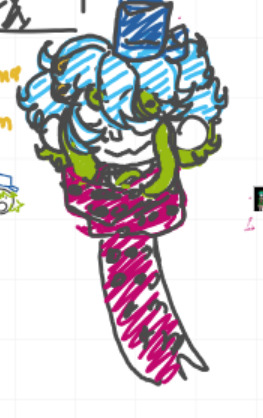


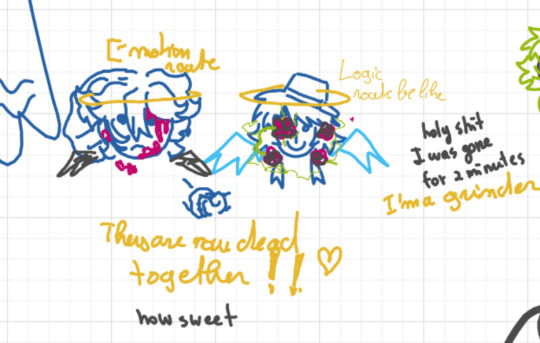
CREATION OF THE RAT ARMY
So me and janice had a discussion has two fellow rats, and i realized that janice didn't have an actual title, but like they have a kanna blog, also go check them out if you haven't they are cool. So i decided as the Rat lord to knight them as the title of Marquess Mac'n'cheese. So here is us!

then came kaory or know here as @reahustar , came on and wanted to become apart of us, so we gave her a name too. She became the Champion of Roses and well she drew herself too.
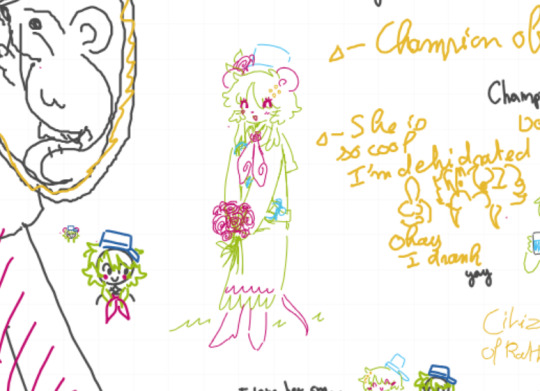
so then we kinda just drew ourselves !
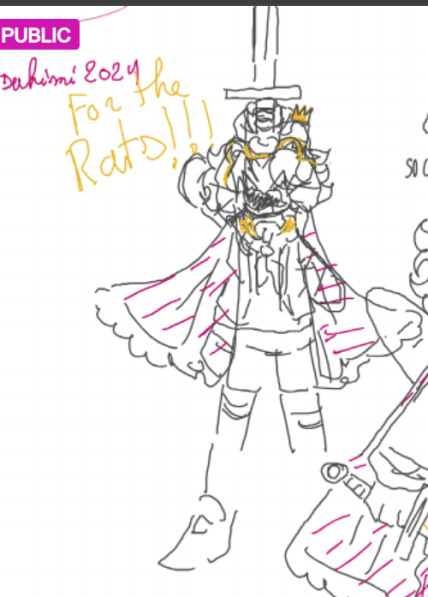
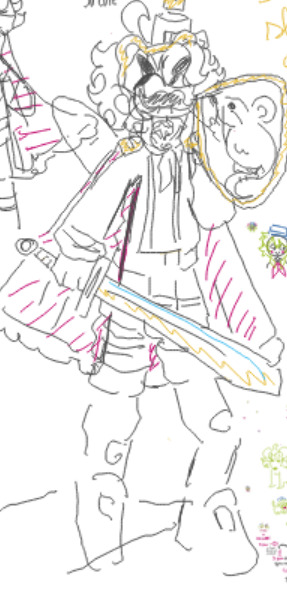


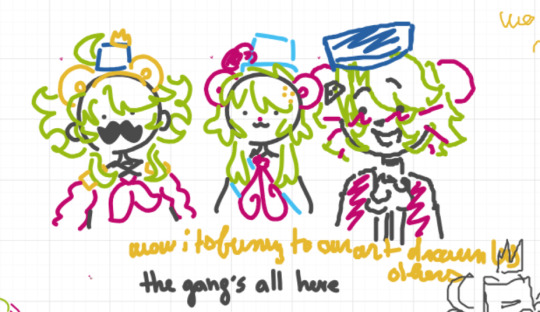

also the last in the last drawing none of us drew ourselves, it can be seen by the art style, just as the drawing where i drew kaory champion of roses
and then finnally came the last rat of the day, @runetallem or nagito komeada looking ass in my book, they came and i gave them a name as always, they were knighted as the the Knight of Mouses!

(the first drawing on the left is rune drawing the one on the right is mine)

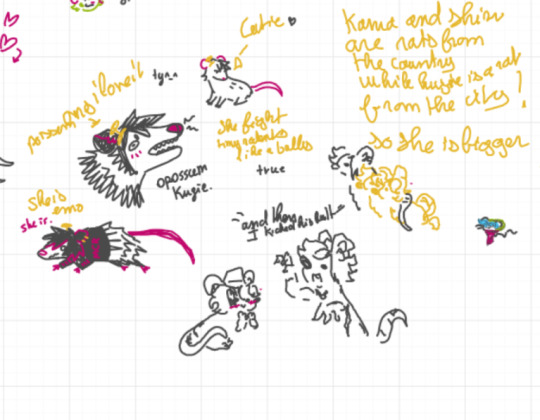
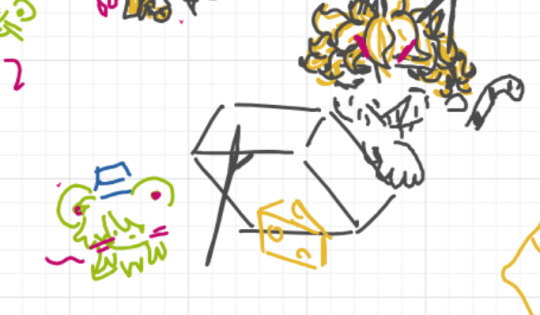


so yeah we have now expanded the rats army, also i forgot but to anyone who doesn't know what a rat is, in short a rat is a silly names for kanna fans.
so yeah it was fun! really cool
#yttd#your turn to die#kimi ga shine#kanna kizuchi#sara chidouin#french is expanding her army#embrace the cheese guys#embrace it
25 notes
·
View notes
Note
an account of trisha warcrimes? i'm dying to know
i'm obsessed with the wording of this ask i feel like i'm presenting a case to her trial or something
blood sacrificed this poor french lady so jowan could exorcise her son (kinloch hold's just too far away man)
gave an immortal blood mage the 👍 to human experiment on her wardens to expand his research on the taint
this is somehow not even the only time she does this
sacrificed amaranthine just to make double sure her fuckass castle was ok (it was already full upgraded)
absent mother
killed yavana during silent grove
stabbed a recruit to death during one of her joining rituals (with duncan's dagger. the same one he killed ser jory with.)
held anders hostage by threat of handing him over to the chantry so his wife would continue helping her investigate the calling
proceeded to then abandon his wife in the raw fade
defended the use of summoning a demon army through blood sacrifice rituals directly to the secondcoming of christ's face
she literally led the "War Crimes Are Ok! ❤️" side during the grey warden civil war
genuinely likes oghren
#trisha amell#ask#i love when people ask about my da ocs unprompted btw im gonna propose marriage to you now
20 notes
·
View notes
Text
Sometimes I mess around with sounds, and every few years I have enough to actually write/compose a song. I've had a few Critical Role-adjacent WIPs on the backburner for a while, but for some reason it only took making up an Exandrian constellation and coming up with a couple of lines of verse for a fic to come up with three entire verses and melody/counterpoint?! Huh.
Fortunately @whisker-biscuit agreed to lend an ear, a helping hand, and her lovely voice, so for once it's not just me fooling around with a mic, but a proper harmony! (Thanks a lot 💜)
Re. what the song is about - in a nutshell, once upon a time in Tal'Dorei, a human king waged a war to expand the boundaries of his kingdom (the Scattered War). There was resistance from elves, humans, halflings, and half-orcs. The song is about the battle of Torthill, where the king attacked a village, found it empty, and was promptly killed during the ensuing speech to his army by a volley of arrows. I made up two riders who rode ahead to warn everyone. And then made it bittersweet, because that's the stuff of legends, isn't it? (also I really love Goethe's Erlkönig. Bit of a downer ending, but it's a great poem.)
Hence, "The Riders". Plus lyrics!
As they rode on through the night, the moons were shining bright No armour but their beating hearts, they had to travel light Through arrows and a storm of swords, exhausted, they rode on The king, they cried, the king has come, he will attack at dawn
As they rode on through the fields, with death hot on their heels, No bow, no swords, no dagger sharp, the dark their only shield, Two riders flying through the land, too swift for death to find, But the ravens come for everyone, one rider fell behind
As they rode on through the town, one looked behind and frowned Two riders left, two horses stopped, one rider touched the ground An arrow stark had found its mark, a hunter found its prey The course now run, the people saved, the rider slipped away
Now they ride on through the sky when the moons are rising high On summer nights when stars are bright you'll see the Riders fly
(It's the first time I write a song while trying to adhere to metre and tonic accents and wow - English is both harder and easier to write songs in than French in that respect :D)
#critical role#music#this is Bel speaking#(maybe I should make a different tag for these things)#anyway#the things you do for fic I swear
9 notes
·
View notes
Note
hiya, back with an arcanist query here.
the jessica trailer got me wondering, just how big is the suitcase crew so far? it seems by the time the green lake folks are recruited, we already have matilda, x, and eagle around. there are also voicelines from other characters implying theyre already in, like zima ("there are not many poems... like the orange one says") and mesmer jr ("...the girl with the potions..."), although they couldve been recruited at any point in time. it just gets me so curious who joined when! 😄 at least i want to know how much it's grown since green lake but we can only speculate. this also feeds into my desire to see the other arcanists get involved in the story, main or otherwise.
like you said with the jessica posts, vertin provides the arcanists with a new path, one outside MV or the Foundation. so another curiousity of mine is how she recruited the others i.e. their motivations for joining her!
My theory is bluepoch just gave us a lot of characters to play from the start with but there is probably a canonical meeting for them (at least I really hope so) that we'll get through events and main story. That being said, I wonder if the people we already know will have an official event where they move in. For example, Matilda storywise is still working at SPDM but maybe she'll get assigned to Vertin's department? Or perhaps she'll be someone who stays in the Suitcase for certain cooperative missions? Ngl I want french ducky to make official appearances in the Suitcase.
If I had to list people currently living in the Suitcase as of right now cannonically, I think it'd be:
Vertin, Sonetto, Regulus, Sotheby, Druvis, Jessica after her Discipline training, Apple, and Horrorpedia. Blonney might join after she graduates from college or when she misses her bambi lol
The list will grow as we see Vertin recruiting. This game is different from others I've played in that we see the start of the crew. Usually there is an established guild or something but we see in real time Vertin's army expanding from her very first member!
I love the way the crew interacts with each other too! An An Lee is trying to terrorize my ghostly babies! I need to see Vertin meeting Tennant and Eternity. And Rabies! VOYAGER! Ahh so many people!
48 notes
·
View notes
Text
As world leaders scramble to avert a full-scale war between Israel and Hezbollah, there is another conflict on a scale perhaps unimaginable to many they should rush to prevent as well.
It is a repeat, like Israel-Hezbollah in 2006, of a war that raged between the Democratic Republic of the Congo, Rwanda and Uganda between August 1998 and July 2003. By the time it ended, nine African countries and 20 rebel groups were involved. At least 5.4 million people died as a result of fighting, disease and malnutrition and 7 million were displaced. Africa’s World War — or the Great War of Africa, as it came to be known — was the world’s deadliest conflict since World War II.
Today, conflict between Congolese and Rwandan leaders has sharpened dangerously, peace initiatives have collapsed, an arms race is underway and deadly clashes between both sides and militias aligned to them are frequent. All the warning lights for a repeat of the 1998-2003 war are flashing.
Tensions have been simmering for years, with frequent reports of serious cross-border clashes in the eastern provinces of Congo. War talk and violence ramped up in the run-up to the Congolese election in December and have intensified over the past seven months. Weeks before the poll, Congolese President Felix Tshisekedi said Rwandan President Paul Kagame was behaving like Adolf Hitler and had ambitions to expand Rwanda into eastern Congo.
"I promise he will end up like Hitler,�� Tshisekedi warned. Rwanda said the Congolese president’s words were a "loud and clear threat."
On July 9, a United Nations expert report confirmed widely circulated accusations that Uganda and Rwanda are backing the powerful M23 rebel group in eastern Congo. The report warned that the crisis "carried the risk of triggering a wider regional conflict." Rwandan government spokesperson Yolande Makolo responded that Tshisekedi had "consistently threatened to declare war on Rwanda" and that her country "will continue to defend itself."
The reasons for the fighting are decades-old and complex, yet currently boil down to various players’ bid to dominate Congo’s abundant mineral resources.
After the 1994 Rwandan genocide, in which 1 million ethnic Tutsi were killed by mainly Hutu ethnic groups, militias implicated in the murders fled into eastern Congo. The Rwandan army pursued them, arguing that it had to arrest perpetrators of the genocide and destroy their networks. This happened again in 1998, triggering the great war and spawning a web of vested interests involving neighboring nations and armed militias, mercenaries, mining companies, local and regional politicians, China, the United States and other global powers seeking a toehold in the region. Large parts of Congo have since been occupied by ruthless armed groups profiting from illegal mining.
The country produces nearly 70% of the world’s cobalt, while the Great Lakes region that Congo is a part of is rich with tin, tantalum, tungsten, lithium and gold — all of which are key components of electric vehicle batteries, cell phones, refrigerators, jewelry, airplane parts, cars and other goods. As of 2020, Chinese firms owned or had stakes in 15 of the 19 cobalt producing mines in Congo. Between 2022 and 2050, demand for nickel will double, cobalt will triple and lithium rise tenfold, according to the International Energy Agency.
A conflagration will potentially affect or draw in other countries. Apart from Congo, Rwanda, Uganda and Burundi, a plethora of armed groups is already in the region. The 11,000-strong U.N. peacekeeping mission (which goes by the French acronym MONUSCO) was supposed to leave the country by year-end, but has been asked by the Congolese government to stay on indefinitely.
South Africa, Malawi and Tanzania already have troops in Congo as part of the Southern African Development Community’s peacekeeping mission deployed there last December. Congo’s neighbors Angola, the Republic of Congo, Tanzania, Kenya and Zambia could be pulled into the fighting. An East African Community Regional Force exited Congo in December and may be drawn back in.
That’s not all. The Global Center for the Responsibility to Protect, a nongovernmental organization, says that there are at least 120 armed militias operating in the region, while mercenaries such as those of Russia’s Wagner Group have been contracted by various players. And worryingly, Congo has been stocking up on arms. The country’s military spending experienced the highest increase in the world last year, according to the Stockholm International Peace Research Institute. Spending on armored vehicles, drones and other military equipment more than doubled in a year to $794 million.
The 1998-2003 conflict ended because strong continental leaders intervened through dialogue. In 2000, African leaders adopted the Lome Declaration that expressly outlawed coups, thus giving the African Union the authority to stand up to belligerents.
The current political climate, called "an epidemic” of coups by U.N. Secretary-General Antonio Guterres, makes it harder to intervene. Continental leadership of the type of the early 2000s is also lacking. In its last meeting on July 12, the African Union — its authority already undermined by swaggering coup leaders in Mali, Niger, Burkina Faso and other nations experiencing democratic backsliding — failed to even place the Great Lakes crisis on its agenda.
Attempts to strike a new peace deal have floundered. On July 27, Tshisekedi told a meeting in Paris: "There are two processes. There was the Nairobi Process driven by Uhuru Kenyatta which, unfortunately, was subsequently managed by the new president William Ruto. He managed it very badly. The process is almost dead."
The second initiative, the Luanda Process led by Angolan President Joao Lourenco, has made little headway after a disastrous meeting in February.
What now? At the request of the U.S., the belligerents have been observing a humanitarian truce for nearly a month, but clashes have continued. This truce should be used by international leaders — U.S. Secretary of State Antony Blinken has admirably been heavily involved with Lourenco — to encourage Tshisekedi and Kagame to dial down the rhetoric and come to the table.
China, which has sold arms to both sides this year and is the dominant foreign economic player in Congo’s mining sector, should do the same. Switzerland and the United Arab Emirates (both of which have mining interests in Congo) should also be acting. Crucially, other regional leaders such as South Africa, Nigeria and Kenya should be taking a leadership role alongside Angola’s president to avert a deterioration and assert Africa’s interests.
With 7.2 million people in the region already displaced by the war — 700,000 of them in just the first three months of this year — a further escalation would spell disaster for the continent.
10 notes
·
View notes
Text
It’s a little interesting but also weird how there’s two books (comic and manga) that’s meant to expand on Dolph’s character and relationships……. And yet they conflict with each other and the show
In the show Dolph doesn’t make any remarks about having anyone note worthy in his life besides Alex and we don’t see any implication that his ex military co workers have any opinions of Dolph being a terrorist outside of “he’s a terrorist!” (besides maybe Red) , we don’t even see any family members referenced outside of a propaganda film that was made to paint Dolph in the worst light possible
Based on what I’ve found thanks to Google book previews, Dolph didn’t have any friends growing up as a military science experiment besides Lucy (who interestingly seems like the only person Dolph had contact with growing up that was around his age) and decided to try to run away from the military system not long after he became 18
But based on the comic’s description and previews , Dolph had at least one close friend , or at least an ally, in his time in the army: Mute

I don’t speak French and I’d really appreciate anyone who has read this and can speak French to shade some light onto this post
But I want to point out that Mute here is a private investigator who is visually shown to live in her own place and has had a girlfriend. Based on information from the manga, Dolph wasn’t even allowed to consider having any sort of sexuality, much less have the independence to have a sex life and live in his own place away from the military career he was raised in
Meaning Mute was not in the same “turning children into Eden’s super soldiers” program that Dolph grew up in, if Mute not being a cyborg wasn’t already an obvious clue to that
While I don’t speak French, it seems based on visuals that Mute and Dolph’s relationship was that of equals and they worked together often enough for Mute to consider Dolph “a former brother in arms”, even though the two have drastically different jobs
But the manga:

Seems a bit complicated to have a work partner who has to do exactly what his boss says, who is speaking directly into his brain and is he daughter of one of the scientists who made him to a weapon before , doesn’t it?
I want to add too is that the French comic doesn’t seem to have any mentions of Alex at all, despite Alex playing a huge role in Dolph’s life and involvement as a terrorist in Eden’s eyes
Seems a bit weird that Mute, a crime investigator, doesn’t seem to make any note about Dolph’s involvement with Alex
it’s rather disappointing that these were meant to expand Dolph’s character but just leaves more questions than answers, but also I’m totally adding this to my case that Dolph has repressed memories and general memory issues
12 notes
·
View notes
Text
The SIDEMASCOTS 2.0 Auditions (Sidemascots 2.0)
The Sidemascots Version 2.0!
Sumi: By popular demand!
Vinicius: By contractual small print more like…
Sumi: And this season is going to be bigger and BETTER THAN EVER!
Vinicius: I’m so tired of entertaining @sashley1912 alone…
Sumi: What do you mean we only have 1 viewer?!
Vinicius: Oh. Hehehe, nothing.
Sumi: Anyway, this season I will EXPAND… my haircut catalogue!
Vinicius: WHAT?
Sumi: Specifically I love this one (grabs a photo of Tom)
Vinicius: That’s Tom.
Sumi: Yeah, and?
Vinicius: Uhhhhh…
Sumi: See you in three hours! I’m going to look good!
Vinicius: Uhhhh… what he meant that the Sidemascots will EXPAND to 12 members! Also by contractual small print by Sumi because managing 8 people are painful, let alone 10…
Sumi: More people, more FUN, eh?
Vinicius: Ugh… let’s begin…
The Sidemascots Season 2 Auditions!
[The auditions]
Miraitowa: Mira-
Sumi: You’re in!
Miraitowa: Wha?
Vinicius: you don’t need an introduction to get in, default Olympic mascot…
(Sirens can be heard behind Vinicius and Sumi)
Vinicius and Sumi: RUNNNNNNNNNN!
Miraitowa: Don’t mess with me! (Mirai laughs with lightning effects on the background)
[The auditions]
Burke: Bur-
Vinicius: You’re in!
Burke: Let me guess…
Sumi: Let me guess…
Burke: I don’t need…
Vinicius: You don’t need…
Burke: LET ME TALK! LET ME TALK!
Sumi: Let him talk! Let him talk!
[The auditions]
Wenlock: Wenlock, Stratford.
Sumi: So why do you want to be in…
Vinicius and Sumi: The SIDEMASCOTS Season 2? Siu!
Wenlock: Well Season 1 was a lot of fun, so I decided to come back! Briefly…
Sumi: hehehehehe, what?
[The auditions]
Miga: Miga-
Sumi: You’re in!
Vinicius: What?
Miga and Sumi: Hmmmmmm… Let me guess…
[The auditions]
Crackhead: Crackhead-
Sumi: Security! A criminal that caused Sidemascots 1.9 is here!
(Sirens are heard behind Crackhead)
Crackhead: Uh… (Turns off camera)
(Vinicius and Sumi laughed)
Vinicius: Well done, co-capitan!
Sumi: Thanks, co-capitan!
[The auditions]
Daiyu: Daiyu Z-
Sumi: Security! An illegal Chinese trespasser is here!
Daiyu: But I was enrolled to a grand mascot sc- (video call ended)
(Vinicius and Sumi laughed)
Vinicius: Well done, co-capitan!
Sumi: Thanks, co-capitan! I’m planning to do the same on ByteDance next!
Vinicius: Ha, what?
[The auditions]
Olympic Phryge: Oly…
Sumi: Can you turn on the camera, Marie?
(Oly turns on the camera)
Sumi: Holy shit! Phryge? I thought it’s someone like Marie! I wish squids were real…
Vinicius: I think you played too much Splatoon 3… in French.
Olympic Phryge: Pffft… Anyway, staaaaay fr-
Sumi: RAAAAAAAAAAAAAAAAAAAAAAH!
Vinicius: Sumi… where did it all go wrong?
[The auditions]
Sumi: Para! Para?
Vinicius: Oh, haha, another trip at a strip club.
Sumi: Never change, Para. Never change.
[The auditions]
Vinicius: “Family statement: @sashley1912 is not available at the moment due to her continuing contamination in a solitary confinement trying to deal with would-be-solvable mental health issues. She will be replaced by her twin.”
Sumi: Replaced by a twin? Who do they think we are? The Beatles?
Vinicius: Paul isn’t dead.
Sumi: Paul IS dead! Don’t be a sore loser in the music community, Vini!
Vinicius: I mean it’s for the better, we wouldn’t allow THIS costume in the Sidemascots. Who do she think she is? A circus performer?
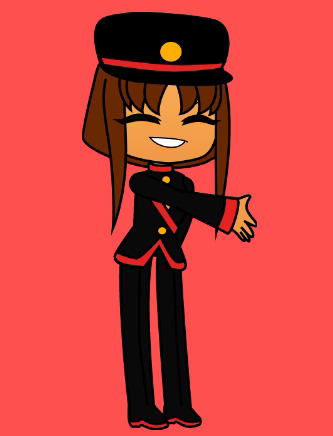
Sumi: That’s an “army” suit.
Vinicius: Army?! The Icelandic Army is WAY better. And they don’t even have an army!
Sumi: Let’s move on. Sorry, Salome.
Salome: Awwwwwww…
[The auditions]
Powder’s clone: Powder, from…
Coal: I knew it! I knew mascots can revive!
Sumi: Actually, no.
Vinicius: She’s just an intern in a rabbit suit.
Coal: WHAT?
Sumi: And because of that, you are BANNED from the Sidemascots!
(Coal cries and ran away)
(Vinicius and Sumi laughed)
Powder: AHAHAHAHAHA! PRANK! OH I GOT HIM SO BAD! SOOOOOOO BAD!
Powder’s clone: Who are you?
[The auditions]
(Someity meditates)
Vinicius and Sumi: NEXT!
[The auditions]
Saola: Sao La-
Vinicius and Sumi: NEXT!
Sumi: To be fair, I want to live in Vietnam someday.
Vinicius: You’re broke.
(Sumi cries)
[The auditions]
Beibei: Beibei from Beijing…
(Vinicius cuts the rope, starts a Sidemascots-themed Rube Goldberg machine)
(Beibei gets squished by a 1 ton weight)
Vinicius and Sumi: YES! (High fives)
Sumi: Well done, co-capitan!
Vinicius: Thanks, co-capitan!
[The auditions]
Soohorang: I’m sorry to say that our pet Moongcho melted.
Vinicius: Where’s Bandabi?
Soohorang: I never see him since.
Sumi: Presumably in a 3-year therapy session…
(Vinicius and Sumi laughed)
Soohorang: …
[The auditions]
Milo: (Plays L’amour Toujours on his homemade accordion)
Vinicius and Sumi: NEXT!
Milo: oh…
[The auditions]
Tina: Tina…
Sumi: AAAAAAAAAAAAAAAAAAH!
Vinicius: She’s not Oly…
Sumi: I ALSO PLAY SPLATOON IN SPANISH! SPANISH!!!
Tina: Why is he…
[The auditions]
Borobi: (pretends to swim on the ground) Borobi, Queensland mate!
Vinicius: Who do he thinks he is? A merman?
Sumi: To be fair, I like his style…
(Borobi continues to swim like a dry fish)
[The auditions]
Vinicius: A Bull?
(Perry the Bull puts his hat on)
Vinicius and Sumi: PERRY THE BULL?
[The auditions]
Zabivaka: What do I want? More money! When I do want it? N-
Vinicius and Sumi: NEXT!
[The auditions]
Vinicius: Who’s next…
Sumi: Mario, Spark the future Canadian, Mickey (again), Scratch Cat, Maddli, Albart, Honohon…
Vinicius: Ugh, that’s a wrap!
Honohon: What about me?
Sumi: oh… we’ll be in touch.
Honohon: Ha! Nailed it.
Uzumin: WHAT ABOUT M-
THE SIDEMASCOTS SEASON 2 STARTING LINEUP!
Sumi: After 10 days of searching…
Vinicius: 2 hours more like.
Sumi: Vini and I…
Vinicius: Sumi mostly.
Sumi: Can you stop-
Vinicius: Stop interrupting me?
Sumi: It’s-
Vinicius: It’s embarrassing.
Sumi: I’m-
Vinicius: You’re an idiot.
Sumi: Ohhhhh…
Vinicius: Ohhhhh…
(Multiple clones of Vinicius appear doing the same “oh” thing)
Sumi: AHHHHHHHHHHHH!
[Technical difficulties]
Sumi: I have decided who will make… THE SIDEMASCOTS SEASON 2! The winged living totem… me!
Vinicius: The winged living mammal… also me!
Sumi: Default- I mean cool Olympic mascot… Miraitowa!
Miraitowa: Yippee!
Vinicius: Atlanta’s #1 United Fan… Burke!
Burke: Go Las Vegas Raiders! on Ice!
Sumi: My pretend sister… Miga!
Sumi and Miga: Hm, let me guess…
Vinicius: Ugh, the scientist who’s gonna be a shining star, she’s going far… Powder!
Powder’s Clone: Yippee!
Sumi: That’s not…
Vinicius: Definitely NOT Marie… Olympic Phryge!
Olympic Phryge: I’m scared…
Vinicius: Don’t worry, no Phryge haters this time.
Olympic Phryge: Pfiou!
Sumi: Ice hockey’s #1 Sasquat-
Miraitowa: My bestie-westie, Honohon!
Sumi: You can’t-
Miraitowa: I can I just did!
Sumi: Fine, Ice hockey-
Vinicius: The white tiger from Pyongyang- I mean PyeongChang, Soohorang!
Soohorang: Yes!
Sumi: Ic-
Vinicius: The ironwork from Thames… Wenlock!
Sumi: I-
Vinicius: The mopper of Queensland… Borobi!
Borobi: Mop, mop, mop!
Sumi: FINALLY! ICE-
Vinicius: And our final Sidemascot… vacant!
Sumi: What?
Vinicius: It says Sacha on the script… Ugh, not you, Salome…
Sumi: How about Quat-
Vinicius: We’re going to start this season with 11 mascots. It’s still more than last season anyway.
Sumi: But-
Vinicius: Shhhhhhh…
Sumi: BUT-
Vinicius: Shhhhhhh…
Sumi: LET ME-
Vinicius: Shhhhhhh… just a reminder that I have a whole bag of shush with your name on it.
Sumi: …
Vinicius: Like and reblog this post! We want at least 10 likes! Make sure to donate to mental health organizations, especially in France! Sacha will thank YOU! Episode 1 drops this weekend! This has been the Sidemascots…
Everyone except Sumi: ADIOS!
Salome: What about me?
Vinicius: Not now Salome!
Tom: AND ME-
#mascotverse#sidemascots#parody#vinicius and tom#miraitowa and someity#possibly controversial#the phryges
2 notes
·
View notes
Text
I am now going to post my SCP OCs because I want to and I'm procrastinating from important thing
SCP OCs list:
Isekai'd reality-bending mad scientist looking for cure for her condition creates two test subjects that she gets way too attached to. Abandons said subjects after surprise Foundation visit. Succumbs to powers and fucking DIES (Thanks GOC). (Alice; Named for "Alison" by Elvis Costello)
Failed experiment #2 has attachment issues and is a very willing test subject. Creator/"Mother" made him functionally immortal to try and preserve experiment/not lose data/not die because of ritual to preserve Failed experiment #1/not die because of Failed experiment #1. (Jack/Jack Flash; Named for "Jumpin' Jack Flash" by The Rolling Stones; DO NOT CONFUSE WITH THE OTHER FUCKER NAMED JACK, I WROTE THIS CHARACTER IN 9TH GRADE)
Failed experiment #1 speedruns that one GOC manual thingy. Starts drawing attention to Creator/"Mother". Last straw was when someone almost hit him on a bike, to which he responds by flicking the wheel to turn in front of an oncoming car. Creator sedates him, can't bring herself to kill him, and decides to try storing his soul in his younger brother, Failed experiment #2. Failed experiment #2 is not doing too well because of it. (Jules/Julian; Named for "Hey Jude" by The Beatles)
Failed experiment #2's therapist and friend. Sweet catholic lady. Very accepting. Not anomalous. Great with kids. Friends-to-Close friends-to-Lovers relationship with Former MTF agent. (Valerie Rose; The name sounded pretty, and she is pretty. :3)
Former MTF agent is currently a security guard. Not anomalous. Mixed race Venuzualan-Italian. Parents are first-generation immigrants to America, and therefore he has triple citizenship and is tri-lingual. Will curse you out in all three languages. Nice to his friends, standoffish to others. Was a US Army Ranger before joining the Foundation as an MTF. Got an injury (still deciding what injury) and was placed on security guard duty. Overworked himself, made the injury worse, and is now permanently on security guard duty. Very bitter about it. Friends with Failed experiment #2, Failed experiment #2's therapist, Frankish vampire, and Cursed doctor. (Jean Rocco; Idk I came up with the last name and it sounded cool)
Frankish vampire born 24 years after the fall of the Western Roman empire. Averse to human blood. Survived by living out of caves, sewers, catacombs, etc. and feeding on animal blood. Born with condition, symptoms developed as he aged. Left village after killing a cat out of desperation and hunger. Speaks a mix of Frankish and Medieval Latin. Eventually learns some French as territories/places/people expand. Learns English after being captured by the Foundation in October 2009. Friends with Failed experiment #2, Former MTF agent, and Cursed doctor. (Bertric Bertram; Bert-: "Bright", -ric: "Powerful", -ram: "Active")
Cursed doctor is a medical doctor who accidently pissed off a thaumaturgist and was cursed to go into a trance-like state everyday and carry someone to a random distance away from their original position. Was picked up by the Foundation after the curse led to him getting assault and attempted kidnapping charges. Has chronic pain from being shot in the side during one of these instances. Staff have to be warned everytime he moves to a different site in order to prevent him from being murdered. Is friends with Failed experiment #2, Former MTF agent, and Frankish vampire. (David Dopravce; Dopravce is Czech for "carrier", "hauler", "forwarder", or "conveyer", according to Google Translate)
3 notes
·
View notes
Text
history of HAIQIN | part VI: era of constant border conflict
------------------------------------------------------------------------------
date: october 2, 2024
------------------------------------------------------------------------------
The Age of Strife (1700s-1900s):
European Threats and Invasions:
Foreign Invasions and Border Skirmishes:
Although Haiqin successfully secured independence in the 17th century, it entered a long period of instability in the 1700s, as other European powers saw the newly independent nation as vulnerable. These nations, especially Spain, Portugal, France, and the Netherlands, were driven by expansionist ambitions and the desire to control the region's resources and strategic location. This led to a series of conflicts, border skirmishes, and attempted invasions throughout the 18th and 19th centuries. While none of these powers fully conquered Haiqin again, the constant threat of invasion kept the nation in a near-permanent state of military readiness, draining resources and shaping Haiqin's society around the need for defense.
Spanish Aggression (Mid-1700s):
Spain, one of the most aggressive colonial powers during this era, sought to dominate trade routes and establish control over Haiqin. In the mid-18th century, Spain launched several naval attacks on Haiqin's coastal cities. These attacks were devastating, with many towns burned and significant resources drained as the nation mounted a defense. Haiqin’s naval prowess, bolstered by alliances with Greece and Ireland, proved decisive in repelling these attacks, though the cost in human lives and economic stability was high. The battles with Spain forced Haiqin to develop innovative naval tactics, which would later form the backbone of its military doctrine.
Portuguese Interference (Late 1700s):
Portugal's ambitions were subtler but equally dangerous. By inciting unrest in border regions and supporting rebel groups, Portugal aimed to destabilize Haiqin from within, creating a long-running proxy war. These conflicts bled the nation dry, as resources were diverted to control uprisings. This period of constant vigilance and low-intensity warfare against Portuguese-backed forces shaped the way Haiqin approached internal security. This was also when the Silver Falcons, a covert elite force specializing in counter-insurgency, were first deployed to root out foreign influence.
French Occupation Attempt (Early 1800s):
Napoleon's conquests extended across the globe, and in the early 19th century, France briefly occupied parts of southern Haiqin. The occupation of key southern cities and ports lasted only a few years, but it was a traumatic time for the nation. Local resistance movements led by generals like Aria Othonos, a prominent female commander, were crucial in expelling the French. Her leadership and strategic use of guerrilla warfare made her a national hero. The French invasion, though short-lived, showcased the resilience of Haiqin’s people and the effectiveness of their hybrid military tactics, blending Greek phalanx formations with guerrilla strategies.
Constant Border Skirmishes (Throughout the 1800s):
Even after major invasions subsided, border skirmishes continued with colonial powers, especially France, Spain, and the Netherlands. Territorial disputes over resource-rich areas, particularly involving valuable minerals and fertile land, were common. These skirmishes were small but frequent, forcing Haiqin to remain in a state of military readiness for more than a century. The Royal Guard was expanded during this time, focusing on rapid response and fortifying key strategic points across the borders.
Haiqin's Military Evolution:
Transformation of the Army:
To resist larger and better-armed European forces, Haiqin transformed its military structure into one that emphasized flexibility, discipline, and the strategic use of terrain. The army integrated Greek-inspired phalanx formations, particularly useful in open combat, with the guerrilla tactics of the indigenous population. Soldiers were trained to operate in diverse environments, from mountain ranges to dense forests, making them adaptable to the varying geography of the nation. Similar to the training King Katalies gave to his troops against Britain.
Navy’s Ascendance:
The navy, once a secondary force, became a cornerstone of Haiqin’s defense strategy. Realizing that control of the seas was crucial to repelling foreign invasions, the monarchy invested heavily in naval development. By the 19th century, Haiqin had one of the most advanced fleets in the region, with ships designed for speed and agility. These ships, combined with cutting-edge naval tactics learned from alliances with Greece and the fledgling United States, enabled Haiqin to maintain control of its waters and safeguard vital trade routes. Notably, during the Portuguese naval incursions in the late 1700s, Haiqin's Ironclad Fleet was deployed, surprising enemies with its superior firepower and maneuverability.
Specialized Elite Units and Espionage:
The Silver Falcons, established as an elite guard and intelligence agency, became one of the most feared and respected military units of the era. These soldiers specialized in covert operations, assassination, and sabotage, often operating behind enemy lines to disrupt invasions before they reached Haiqin's shores. Their successful use of stealth and guerrilla tactics greatly influenced military strategy. Moreover, Haiqin established a vast spy network inspired by the legendary figure Sloane Tuoapizan, sending agents to gather intelligence in enemy nations, disrupt supply chains, and infiltrate foreign governments.
Diplomatic Maneuvering:
Alliances with Greece, Ireland, and Scotland:
These alliances, forged from a shared experience of resisting colonial powers, were crucial to Haiqin’s survival. Greece, Ireland, and Scotland provided vital military support, including tactical advice, supplies, and troops. Cultural and intellectual exchanges flourished, and these nations helped bolster Haiqin’s defenses against its more powerful adversaries. These alliances were also critical in ensuring that European powers were forced to fight on multiple fronts, reducing the pressure on Haiqin.
Naval Pacts with Greece and the United States:
By the mid-18th century, Haiqin had entered into naval agreements with Greece and the United States. This partnership allowed for the exchange of ship designs and naval tactics, strengthening Haiqin’s maritime defenses. These pacts also ensured that Haiqin could secure vital supplies and resources during times of conflict.
Cultural and Trade Exchanges:
Though Haiqin’s policies became more isolationist, the nation did not entirely shut itself off from the world. Controlled trade routes remained open, especially with trusted allies, allowing for an exchange of goods, ideas, and cultural practices. These exchanges helped foster a sense of shared identity and bolstered Haiqin's economy during the turbulent centuries of conflict.
Internal Consolidation and Isolationism:
Tightening of Trade and Travel:
By the late 1700s, the monarchy adopted an isolationist policy aimed at safeguarding Haiqin from foreign influences. Strict regulations were placed on trade, limiting foreign merchants to specific ports and requiring extensive background checks. Diplomatic relations were primarily reserved for allied nations, emphasizing the need for security and control. This protective stance sought to insulate Haiqin from espionage and subversion while consolidating the monarchy’s power.
Trade Networks:
While isolationism prevailed, Haiqin prioritized trade with trusted allies, ensuring the supply of essential goods and resources necessary for ongoing military campaigns. Trade with Greece flourished, with exchanges of olive oil, textiles, and military supplies bolstering Haiqin's economy. The government implemented policies that encouraged local production and self-sufficiency, reducing dependence on foreign imports. Agricultural innovations led to increased yields, allowing for surplus exports that contributed to national wealth.
Internal Consolidation:
Isolationist policies facilitated the centralization of power within the monarchy. The Vasilios dynasty streamlined governance, establishing a bureaucratic state that exercised control over military, economic, and educational institutions. Provincial governors, appointed by the crown, implemented policies that aligned with royal interests. Although local governance was granted some autonomy, ultimate authority remained firmly in the hands of the monarchy, fostering a stable but sometimes contentious relationship between the crown and local leaders.
Cultural Renaissance and National Identity:
Military and Technological Innovations:
To fortify its defenses, Haiqin invested heavily in military research and technology. Drawing inspiration from successful military traditions, the nation adopted new weaponry, including improved firearms and cannons, and fortified its coastal defenses. Innovations in military engineering led to the construction of impressive fortifications along key borders, which played a critical role in resisting invasions. By the mid-1800s, Haiqin’s military was recognized as one of the most technologically advanced forces in the region.
Cultural Renaissance:
Despite the strains of warfare, the period witnessed a flourishing cultural renaissance. Haiqin embraced its dual heritage, celebrating both Greek and Native traditions through education, art, and literature. Schools were established to teach the histories and languages of both cultures, while national symbols, such as the Daggered Rose Flag, emerged as powerful emblems of unity and resilience. Festivals celebrating poetry, music, and dance became integral to national identity, promoting a sense of belonging and pride.
Non-lethal Duels:
The practice of non-lethal dueling emerged as a unique cultural tradition in Haiqin, allowing individuals to resolve disputes honorably without resorting to deadly violence. These ritualized combat scenarios were characterized by strict rules and formalized conduct, reflecting Haiqin's values of strength and honor. The duels served to reinforce social bonds and demonstrate martial prowess, contributing to a sense of community amidst the backdrop of conflict. These were also used as a form of entertainment. Usually held in the Hanging Crescent Arena within Nirin
The Role of Women:
Women in Power:
Women in Haiqin held influential roles in political, military, and cultural spheres, challenging the norms of the time. Inspired by pioneering figures like Sloane Tuoapizan, women rose to prominence in espionage, diplomacy, and military leadership. They acted as regents, advisors, and cultural patrons, shaping the nation’s policies and contributing to its defense.
Female Spies and Warriors:
Haiqin’s military culture celebrated women's contributions, recognizing them as capable warriors and strategic leaders. Notable figures like General Aria Othonos emerged, leading successful campaigns against foreign invaders and inspiring future generations. Women became integral to the espionage network, providing critical intelligence that aided in thwarting invasions and securing the nation’s borders.
Cultural Contributions:
Women significantly impacted Haiqin’s cultural life, excelling in the arts and gaining recognition for their creative works. Female poets, musicians, and painters contributed to a vibrant cultural landscape, often focusing on themes of resistance, strength, and national pride. Their contributions fostered a sense of unity and identity among Haiqinian people during times of adversity.
Society Under the Monarchy:
The Growth of the Monarchy:
Throughout the 1700s and 1800s, the Vasilios dynasty became the embodiment of national pride and resilience. Monarchs personally led military campaigns and were deeply involved in state affairs. As the nation grew wealthier, however, tensions began to rise between the monarchy and the merchant and land-owning classes, who sought greater political representation.
Formation of Provinces:
To better manage its territories, Haiqin established ten provinces, each with distinct regional identities. While these provinces were initially under direct royal control, they gradually gained autonomy over local trade and governance. However, the monarchy retained ultimate authority over national security, ensuring a centralized approach to defense against foreign threats.
#reality shifter#reality shifting#shiftblr#shifting community#shifting#shifting motivation#shifting reality#dr scrapbook#dr world#reyaint#anti shifters dni
2 notes
·
View notes
Text
📚April 2024 Book Review (Part 2/3)📚
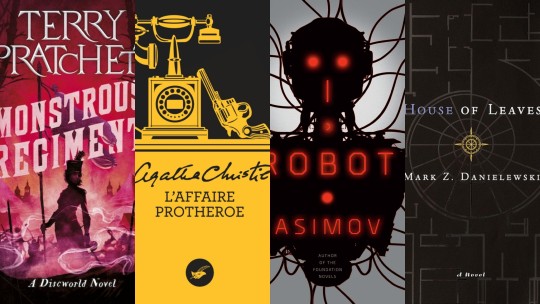
Lots of "first" this month: there are so many classic authors I had never read before! But they were all really enjoyable, it is another good batch.
Monstrous Regiment by Terry Pratchett

To save her family's pub, Polly Perks has to find her brother, a Missing in Action soldier of the Borogravian army. She disguises herself as a man and enlist in the army under the name Oliver. A brilliant idea she might not have been the only one to have.
This one I was impatient to read, the concept was such a classic of fantasy novel that I had high hopes Terry Pratchett would make something awesome out of it.
I love the characters in every Discworld novel but this one especially: all the soldiers have different reasons to be here but they all stay together and care for one another. And I love the clown car effect of "surely this one isn't a woman too!" I couldn't get enough of it.
The story in itself is a bit blury in my memory, sorry. It's probably because I listen to the audiobook and I sometimes lose sight of the plot, on top of it being 5 months behind me. I remember most of all the Nuggan's ever expanding list of Abominations (religious taboos which includes the color blue, people under 3ft tall and sneezing) and the question of The Duchess (deified ruler of Borogravia) being alive or dead.
The message of the novel isn't subtle but if you need to be told that war is bad, religious bigotry and jingoism are bad and misogyny is bad you might be beyond subtlety. I love that Terry Pratchett is definite in his position, razor-like in his satire but always entertaining and funny. Fantasy is a political tool and he proves it everytime.
And (because I am still a fangirl inside) I had my little Vimes cameo as the cherry on top. 10/10 no notes.
Murder at the Vicarage (L'affaire Protheroe) by Agatha Christie
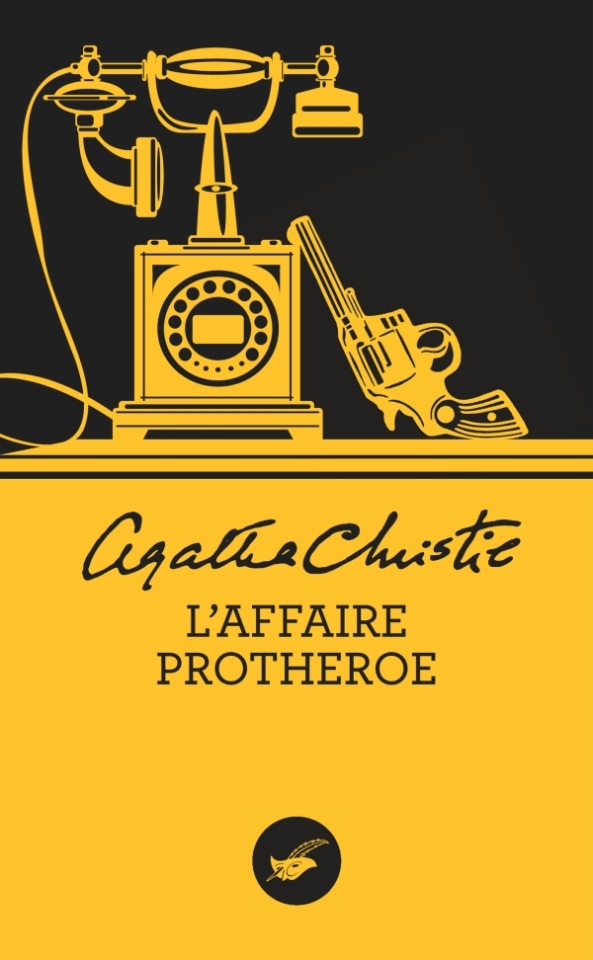
The Colonel Propheroe is widely disliked in the village of St Mary Mead, even his wife is cheating on him. So when he is found shot dead and with a strange half written note, there is no shortage of suspects, not even the Vicar with his very unkind words a few hours before. Miss Jane Marple, the Vicarage's neighbour, decides to solve the mystery.
My first Miss Marple novel! I have absolutely no reading order, this is a bit disjointed so I thought it was my first Christie but I remembered that technically I read And Then They Were None some time ago, it just completely slipped my mind. At that point I hadn't read any Hercule Poirot either so I was quite fresh to Christie's writing and ready for the challenge.
I made the questionable decision to read her novels in french because I wanted to give myself the best chance to solve the mystery. I thought reading in my native language would be easier. Well, apparently the most common translation is old and really not that great so I might rethink that! But for the foreseeable future (at least september) I will have read them in french. And completely failed at solving the crimes but that's another issue.
I don't want to say too much about the plot because that's the whole point of a whodunit but Agatha Christie always has the art of making an asshole the victim of the murder and you still want to know who did it just for the thrill of the chase.
But what I love with Christie is her detectives. The characters are usually quite flat and archetypal, but Poirot and Marple are a delight. Where Hercule Poirot is well established and respected in his craft, Miss Marple is just the nosy neighbour with a sharp mind and an even sharper tongue. The narrator is just so done with her putting her nose in this case which makes it even funnier. I love Miss Marple so much, I want to be her when I grow up.
I was absolutely lost in all the clues, so I did not deduce any part of the revelation but even if I had I would not have seen the murdered coming, I was floored. Everything is there, you know it is, and the culprit still takes you by surprise. Great job Mrs Christie, you did it again.
I, Robot (Robots #1) by Isaac Asimov
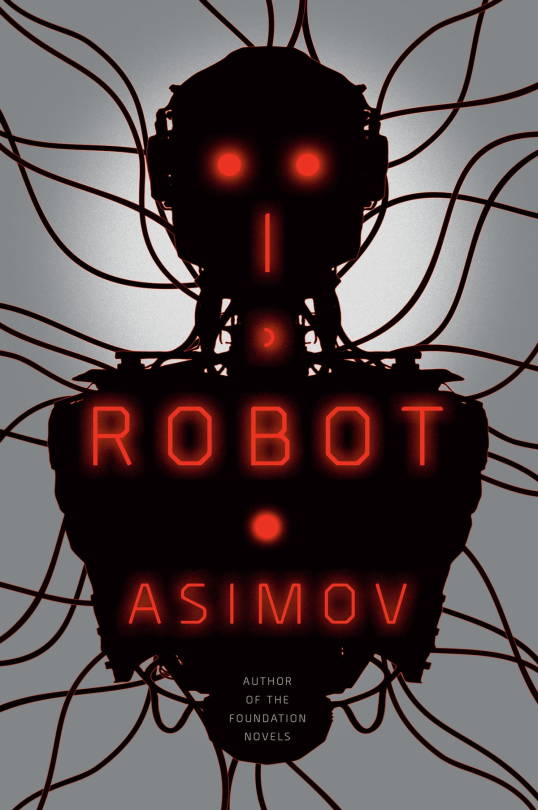
In the 2050's Dr. Susan Calvin, famous robopsychologist, answer a reporter's interview and tells him several stories about robot intelligence and their interaction with humans.
Asimov is a legend in SciFi so it was a prerequisite in my discovery of the genre. I read very few short stories anthology so I was a scared I wouldn't enjoy it but as always good books prove me wrong.
I don't remember all the short stories, the one who stuck to me are Robbie, Reason and Catch that Rabbit! but they were all good. Some more compelling than others (Catch the Rabbit! stayed in my memory because I STILL don't understand it) but I'll try to give an overall review rather than story by story.
The play on the Three Laws is at the heart of almost all of them: either it is a source of conflict or it helps in the resolution but it is endlessly creative.
Susan Calvin is an interesting character: a woman, pioneer in her field, a respected authority and she represents a more serious and scientific approach. The stories in which she appears are very murder mystery-like: there is a problem, some set of rules; how do you use the rules to solve the problem? Boom, done.
On the other hand you have the more comicsl stories with my goats: Mike Donovan and Gregory Powell! They approach each assignment as if it was some punishment in a hell design specifically for them (mood) and their first step to solving any problem is always to complain about it and bucket with the other. They are such and old couple together, please give me 10 more shorts stories with Donovan and Powell!
House of Leaves by Mark Z Danielewski
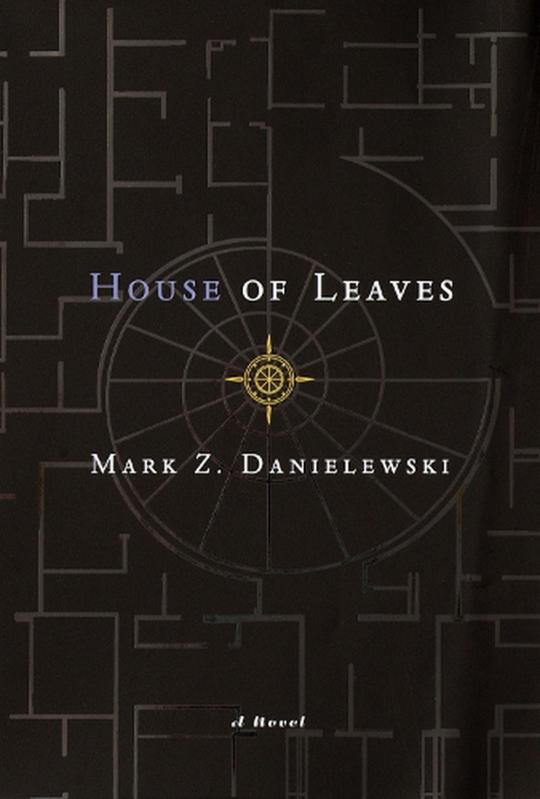
While rummaging in a dead man's appartment, Johnny Truant found a stack of paper, disorganised, written on scraps of paper, some half destroyed. Johnny will lose himself trying to organise the notes, which turn out to be an essay on a documentary film called The Navidson Record. In this film Navidson, a famous photographer, records the exploration of the house he moved in with his family and the strange dark hallway that appeared in the living room.
I've heard about House of Leaves A LOT and had no idea what it was about, I thought it was some dark academia novel and since Fourth Wimg I am weary of social media's popular book rec. A booktube account I follow talked about it and although its reviews was very lukewarm, I was intrigued. The dedication sets the tone: "this is not for you" and that finished piquing my curiosity.
I loved the actual House on Ash Lane subplot the most: it's the heart of the book, the most mysterious and the spookiest. I loved the mise en abyme, and how it saltoed back to be a book in the book's universe. The academic paper language and scientific description of the events contrast with the uncomprehensible nature of the house and the format growing more and more indecipherable as the exploration of the house progresses. It was creepy, I felt pulled in the story, I deeply enjoyed that.
I was more lukewarm toward Johnny's subplot. Watching him slowly lost himself in Zampano's work and lose his grip with reality was chilling but there came a moment where I was lost in references. It was mostly the part with her mother where you can't say what is dementia and what is real. Some theories online are interesting but some or batshit insane and made sense of a small element of the book at the expense of all the rest. At least the Labyrinth under the house doesn't make sense in a somewhat linear matter. I can deal with linear nonsense. The fact that some part of the book (some of his mother's letters and poems) are still undecyphered (That's not just a matter of turning the book upside down) was just frustrating to me: there's content here and I just can't read it? Why?
I read it while oscillating from the french paperback (there's no way you can read it on an e-reader) and a pdf of the original I found in the subreddit for the book. Sadly there's a lot that's lost in translation but also some translating choice I am still pulling my hair about. (September 19, 1988, in which the words aren't translated literally, the name of Parisian streets and landmark aren't the same... either they were throwing things at the wall trying to see what sticks (unlikely) or they knew something us reader don't...)
Overall it is an interesting book, I understand the craze. However I am not obsessed enough to spend much of my free time trying to decypher it. I lurk sometimes in the subreddit trying to see if someone came up with an interesting theory but not much more.
#book review#bookblr#books#terry pratchett#discworld#monstrous regiment#agatha christie#murder at the vicarage#murder mystery#i robot#isaac asimov#sci fi#house of leaves#mark z danielewski#miss marple
3 notes
·
View notes
Note
I've had this miraculous au idea for a while, and I think I'm ready to talk about it. So, pretty much the idea is that instead of they miraculous heroes going up against evil miraculous holders instead they fight against supernatural beings. Full on magic vs. magic. We could see the heroes fight things like a necromancer creating a ghost/skeleton army using the skeletons in the Paris Catacombs, a pack of evil werewolves, a colony of vampires trying to create a hivemind Salem's Lot style, a black night with a corrupted excalibur, a kelpie, a water monster luring in the local pool, the fae, the faewild, or (playing of French mythology) the Beast of Gévaudan (or it's ghost), Gargouille (a sea serpent that terrorized the French countryside before being killed by a Saint and then being turned into the first gargoyle) that got resurrected and is bring gargoyles to life to living to attack Paris. Maybe the miraculous could be the reason why all these creatures are in Paris (assuming this could also be an idea for what could happen after Hawkmoth is defeated, since I'm really not into of the show’s villain being another butterfly user after five seasons of it (which was already too long)(plus I don't care enough about Lila and her shitty writing and dumbing down all the people around her to make her work to really care about her as a villain). Maybe all the magic from the miraculous has drawn all these creatures in, turning Paris into a magical beacon, going off the idea that magic attracts magic.
Honestly, sounds cool
Is pretty much what I want to do in my rewrite of the series, instead just one villain, there is more, like magic creatures, monsters and even foundations, just to expand the world instead of having one enemy the all series
11 notes
·
View notes
Note
Any recs where the heroine is just badass? She knows what she wants and goes after it (hopefully a man/woman) I want to read more than just a wallflower sort of heroine.
The Viper by Monica McCarty: You'll never get more badass than Bella MacDuff, who defies her husband and his political views and escapes him to crown Robert the Bruce, and survives torture and imprisonment because of it (and she's also a real person!). There are other Highland Guard books with badass heroines (The Arrow and The Ghost come to mind) but Bella is honestly on her own level.
The Conquering of Tate the Pious by Sierra Simone: Two strong heroines; Adelais is a Norman warlord who takes over from her late husband during the Invasion, and Tate is the abbess of Far Hope Abbey which Adelais is trying to take over, and Tate basically offers herself up to Adelais to prevent this.
The Black Hawk by Joanna Bourne: Justine was raised to be a child soldier/agent for the French Secret Service in Napoleonic France, and she and the hero Adrian play this decades-long cat-and-mouse game as they switch between enemies and allies, and they eventually become lovers as well.
Lord of Scoundrels by Loretta Chase: Jessica is super self-possessed and has no qualms about shooting the hero after he publicly ruins and rejects her, and then indirectly threatening to spill his simpy behavior in a court of law for public record.
An Island Princess Starts a Scandal by Adriana Herrera: Honestly both the heroines are badass in this one, and in different ways; Cora is a business mogul who wants to expand railways in South America, and Manuela is super into Cora from the start and chases after her right from the start. There's a very hot scene where Manuela finally breaks Cora via reverse psychology and Cora storms into a party and demands Manuela be fetched and brought into her carriage for imminent seduction.
Cutthroat Countess by Minerva Spencer: Jo is a strong, silent type and is great with knives which comes in handy when she takes down half a private army in Napoleonic France; definitely a gal with a particular set of skills. She also has a pet raven!
Grace Callaway's Lady Charlotte's Society of Angels series has all kickass heroines who work as investigators and are generally very forward when it comes to expressing desire to their love interests. I'd specifically recommend Charlotte and the Seductive Spymaster because Charlie is this hypercompetent lead investigator who does so much good work for women who have nowhere else to turn.
Sarah MacLean's Hell's Belles series generally has strong feminist heroines, all of whom are operating outside the law to help women and kick ass. Heartbreaker is a personal favorite of mine; the heroine has criminal origins and uses her social invisibility to break off unwanted matches for women.
If we're talking about heroines who unabashedly chase after their love interests, then I can recommend no better than When a Girl Loves an Earl by Elisa Braden. Viola is obsessed with James to the point where the entire ton refers to her pursual of him as the “Tannenbrook Hunt”. And Olivia and the Masked Duke by Grace Callaway (from the aforementioned Lady Charlotte series) also has similar vibes except with an age gap and a hero who feels suuuuuper guilty about his attraction to Livy. At first.
#book recs#elisa braden#grace callaway#sarah maclean#minerva spencer#adriana herrera#sierra simone#loretta chase#joanna bourne#monica mccarty#historical romance#romance novels#ask
4 notes
·
View notes
Note
ooh, are we making fun of NFCV again? i wanna add to the pile re: how all the so-called "diversity" and "representation" it gets praised for goes overwhelmingly, if not entirely to the bad guys - and half of them don't even have a speaking role or even names, or at least we don't learn about them anywhere else besides the supplementary material, like in the case of drac's vampire generals (except godbrand, of course). even the two PoC good guys i can think of, zamfir and greta, aren't that great considering zamfir is portrayed as hopelessly and delusionally devoted to the deceased targoviste royalty, to the point of forsaking the wellbeing of both the underground and aboveground survivors, and then dies anyway in service of that delusion. and greta's just a last-minute newcomer to allegedly address grant's conspicuous absence that fans were complaining about from the start.
We never stop making fun of NFCV lol, there's always something new to point out 🥰
I can see how fans would respond to this that representation doesn't need to be relegated to heroes only, and you can have minority villains as long as they're not stereotyped. But yeah, the representation in NFCV is shallow at best and offensive at worst.
Most Generals in Dracula's army don't have a speaking role. Cho, the Japanese vampire who goes down in less than a minute in S2, gets a flashback after she died, because storytelling.mp4, and even then she doesn't talk. I only remember Raman's name because Carmilla says something like "there are only 4 women in this castle" nope it's just 3 of them lmao
Sumi and Taka look identical despite not being related according to Word of God, which is hysterical to me because you know they said that to divert the accusations of incest. my pal. you really think your GoT-inspired show is above twin siblings having a threesome? Also, you know, they immediately jump to rape by deception without a hint that they'd do that through all season, and then their corpses get graphically mutilated and pissed on (contrast this with the white, most likely French Lenore who gets to flirt and be cute with her victim)
Isaac is gay! How do we know that? He "jokes" out of nowhere about kissing Hector, a guy he has zero respect for. This line has no follow-up and is OOC with how serious the character is always portrayed. And that's not counting his declaration of love made to his abusive master when he was a boy.
I don't know enough about Islam to have a solid opinion on how it was treated in Isaac's case, and in a vacuum having a "complex" Muslim anti-villain is more original than usual. But I don't like how his self-flagellating habit was first treated as a result of his traumatic past, then as a religious practice, then completely dropped. Using Mohammed's own words about Hell being emptied, which from what I've read mean that in Islam hell is transitory, and twisting them to justify his necromancy is... certainly a delicate choice, but again, he doesn't really reflect on this in S4, he just jumps to "wow I sure love having agency!"
Also, in retrospect, it would have been much better if Isaac hailed from the Emirate of Granada instead of being a slave, a backstory more befitting for N!Annette for her origins and time period. In his case, it would have been more original, and expanded the world a little more. What's that? He wouldn't have a reason to hate humankind? Then how come game!Isaac can do it just fine? :) You know, since he was persecuted (maybe even by the Spanish Inquisition!) for his cursed powers? :) maybe you can have more reasons to hate humans than "former slave"? maybe black people can be depicted as something different than slaves? :)
Striga and Morana are cute together, but are non-entities who begin and end with each other. Also, funny how Morana, the lesbian of color (triple minority!), is literally the most useless and wasted of the four :) and even then the most characterization she gets is "she loves to torture people". nice
Alucard was made bi by Word of God and I don't need to repeat how appalling it is. I hate that most "antis" have a problem with him being attracted to men in the first place, and not that the declaration was made to downplay his sexual assault.
(meanwhile Carmilla, inspired by the literal archetype of the lesbian vampire, to the point that you can even see her game version as being a lesbian thanks to Laura, gets reduced to joke that she'd only sleep with Godbrand if all the men, half of the women and some of the animals died. but hey, she's a radfem, I guess that's enough)
Apparently I have... controversial opinions on the choice of darkening Hector's skin and the ethnicity he is in this version. But I will say that there is something weird in deliberately giving him bronze skin, I suppose to emphasize his Greek heritage, and then spending two seasons literally dehumanizing him and lowering him to the level of a dog and pet.
Also something about the Speakers, nomadic people whose oral traditions get made fun of, by Sypha in particular who calls them idiots, is... hm. The wiki even points out: "They are also similar to the Jews (especially due to their reverence for knowledge and their tradition of oral history) and, to a lesser extent, to the Romani."
I skipped Zamfir's plotline because by S4 I had burnout, but yeah, Greta is probably the best character of color and even then she's little more than a generic badass woman with attitude. Also she's even more ambiguously brown than Hector, I would say on the same level as Casca from Berserk - you can tell she's not white, but she's not really anything else.
(btw no, she has no relation with Grant :) )
tl;dr: the only good representation in nfcv are the tunisi people isaac speaks to and this is why i do not trust them with black annette, and i hate the fucking discourse on twitter from people who just don't like the design change
11 notes
·
View notes
Note
If you had to create a roster for the Einherjar (without using those already on the list) who would you pick from history?
For a more fun one let’s play which Isekai characters would you pick to be an Einherjar?
This was quite fun to do!
1. Alexander the Great, educated, a strong warrior before he was king, responsible for sacking the Persian Empire, but even when the Persian King fled, he left the coward king’s family unharmed, showing that he was also compassionate. He died young and his heirs were assassinated shortly after and the empire promptly fell apart without his guidance.
2. Genghis Khan, one of history’s most infamous leaders, conquered the Mongol Empire plus most of Asia and Europe during his reign. A strong warrior and brilliant tactician who ruled his massive army, and had so many children with various women that his descendants could form their own army today. I love the mystery that nobody knows how he died or where his body is.
3. William Wallace, famous for leading Scotland to its freedom from the English, he may have not been the one to actually do it, but his actions as a warrior and a leader set in motion to the Scots rising up against King Edwards I following his death. His death was tragic, being betrayed and then executed in horrible ways and having his severed body parts displayed around England.
4. Miyamoto Musashi, a ronin samurai who killed his first person at age 13. He traveled alone with no affiliations to train his skills with a sword, which resulted in nito ichi-ryu, better known as kensai, battling with two swords. His most well-known fight was against Sasaki Kojiro, which he won, but then retired to train others with swords and retired with an undefeated record of 61 duels.
5. Spartacus, warrior turned slave turned gladiator turned rebellion leader, courageous but compassionate, a ruthless warrior who offered his enemies both mercy and respect, and led an army of rebels against their oppressors, the Roman Empire.
6. Achilles, who led the Greek army against Troy, killing Hector at the gates, a proud and strong warrior and leader, but he needs to make sure to wear iron boots that are impenetrable as everyone knows his weak spot.
7. Ching Shih, a female pirate who commanded 300 ships and was able to go toe-to-toe with the Chinese Imperial Navy. If you disobeyed you were immediately executed, but the same went for if her men raped captives, she had a no tolerance policy. She ended up getting to retire with all her wealth after the Imperial Government offered both her and her crew amnesty after they were defeated under the agreement that they would stop.
8. ‘Mad Jack’ Churchill, a British solider in WWII that charged into combat with weapons that were not common for the time, such as a sword and long bow. He was disappointed the war ended with the bombings of Hiroshima and Nagasaki, as he wanted to keep fighting. He once stormed a German held down in Italy with just one other man and captured a mortar position and 42 men with just his sword, long bow and his bagpipes.
9. Amanirenas, one eyed ancient queen of Kush, now modern day Sudan, who fought back against the Roman Empire, after the death of Cleopatra, when they decided to try to expand past Egypt, so viciously that Rome and Augustus were quick declare peace between the two empires after they couldn’t win due to the unbearable heat and the pissed off queen. A fierce tactician who used supposedly used war elephants, fed captors to her pet lion, and defaced Augustus’ statues and kept the head of one statue under the feet of the throne of Kush.
10. Lyudmila Pavlichenko, deadliest female sniper in the world; sniper for the Soviet Union in the Red Army during WWII; nicknamed Lady Death and claimed, during her time as a sniper, to have killed 309 soldiers. Became an advocate for peace and toured the world.
11. Jean-Eugene Robert-Houdin a French watchmaker, illusionist, magician and regarded as the father of the modern style of conjuring, having brought magic from something only seen at circuses or similar places like that for the poor, to something of grand entertainment for the wealthy.
12. Richard I of England, a bad king but a brilliant warrior, having spent most of his time in the Crusades, rather than running his own kingdom, or fighting against France
13. Ragnar Lothbrok, Swedish and Danish king, legendary Viking warrior leader who raid both the British Isles and the Holy Roman Empire in the 9th century
As for Isekai~
1. Ainz Ooal Gown- Overlord
2. Rimuru Tempest- That Time I got Reincarnated as a Slime
3. Canya- In the Land of Leadale
4. Azusa Aizawa- I’ve Been Killing Slimes for 300 Years and Maxed out my Level
5. Yuna- Kuma-Kuma-Kuma Bear
6. Albedo- Overlord
7. Diablo- That Time I got Reincarnated as a Slime
8. Shiraori- So I’m a Spider, So What?
9. Seiya Ryuguin- Cautious Hero: The Hero is Overpowered but Overly Cautious
10. Mamako Oosuki- Do You Love your Mom and Her Two-Hit Multi-Target Attacks?
11. Diablo- How Not to Summon a Demon Lord
12. Hajime Nagumo- Arifureta: From Commonplace to World’s Strongest
13. Teacher and Fran- Reincarnated as a Sword
19 notes
·
View notes
Text
So a while back I was at an art museum and I saw a piece by a Pakistani woman, Naiza Khan, from this collection and I wrote down her name so I could look her up later and I really wanted to share what I found because her works are really cool. The museum I went to wrote about the piece that it was ambiguous whether the sculpture was meant to be viewed as restrictive or protective, and I liked that angle a lot. This page I posted the link to expands upon that even further and I wanted to share some of my favorite passages:
“In writing about her installation piece The Crossing in which suits of armor created around the female shape set sail in a wooden boat, Naiza drew attention to the year in which she made the installation—1429 Zil-Hajj, an Islamic echo of the Christian calendar’s year 1429 in which Joan of Arc led the French army to victory in the Battle of Orleans. In Pakistan, 1429 Zil-Hajj started during the 40 day mourning period for Benazir Bhutto—like Joan of Arc, a female leader who polarized opinion and died brutally, reviled by some, sanctified by others. The empty suits of armor speak to the history of both women, and force us to ask in which calendar we’re living—15th century or 21st?” (Page 8, Kamila Shamsie)
“… the fact remains that many of the armored pieces are, as Naiza puts it ‘designed to fit the imagination rather than the body.” (Page 10, Kamila Shamsie)
“Those gilded wings might be armored, but the real threat to them comes not from outward attack but from their own forgetful nature. When dreams or imagination descend, or cross over, into another space they are in danger of losing part of themselves.” (Page 10, Kamila Shamsie)
“Her turn to the hard and unyielding metal bodily implements, which include charged objects such as chastity belts, metal corsets, and lingerie made with steel, suggests that the tension between the demands of the social order, and the intractability of the body has sharpened considerably in her recent work.” (Page 12, Iftikhar Dadi)
“What is the possible relationship between obsolete European implements that seek to shape and control the female body, and modern Islamic legal, social, and ethical injunctions for women? Is modern, scripturalist Islam simply being equated with medieval European repression, torture, or confinement? Or, as the reuse of such devices by S & M, bondage and other subcultures in the west suggests, have these devices today primarily acquired the aura of a transgressive fetish?” (Page 12, Iftikhar Dadi)
“Naiza’s work demonstrates that freedom for women is not a simple matter of transgressing or overthrowing repressive social mores, as the very delineation of what is possible to accomplish as an agent emerges within the discursive constraints of the social order.” (Page 19, Iftikhar Dadi)
“Naiza’s work insistently reminds us of this paradox of subjectivation. In order for the voice and the body of the woman to emerge into public space from a condition of invisibility and subalternaity, its presence must be recognized and shaped by discursive norms.” (Page 20, Iftikhar Dadi)
A quote from Naiza herself reads: “I made some images in my little book in July last year [2006]. These were drawings of “bullet proof vests.” I was intrigued by them, and felt they needed to be made in metal. At the same time they felt like something very soft, close to the body, like fabric… The idea of trapping and protection comes together in these pieces. An ambiguous thought, not sure where one idea stops and the other begins… something so prevalent in our society.” (Page 21, Naiza Khan)
“The welding points on the metal armatures are further allegorized as Heavenly Ornaments, suggesting that the terrible beauty of the violent forging of the metal joint is a necessary accomplice for subjective expression. The works in metal do appear to offer a choice—the ability to wear them or discard them at will. But this choice is essentially an impossible one, in that it is situated between the inarticulate, excessive, and private body, and the normative female body that is increasingly public and visible but forged by discursive norms that allow it to speak only by simultaneously working both violence and protection upon its bodily excess.” (Page 23, Iftikhar Dadi)
I encourage you to read the whole thing, because there’s a lot more discussion of the politics of her pieces, both in terms of feminism and Islam, and about how the artistic choice of her refusal to showcase head coverings (and, to a lesser extent, western beauty standards as well) in her physical works (while addressing them in written works instead) is symbolic. I really like the idea of the clothing being stuck between protecting you and harming you, showing you off but in a consumable way, and how she touches on the false perception of the choice that we have in the matter. She also has some other really cool works shown elsewhere on her website that aren’t part of this set (lots of watercolor!), some of which seem to be inspired by living conditions of people in Pakistan, the ocean, or South Asian history. She also has an instagram if anyone is still using that and wants to check out more of her work.
#women#women in art#women’s art#pakistan#islam#muslim women#muslim artists#radfem#radical feminism#south asia#south asian women#pakistani art#naiza khan
13 notes
·
View notes
Text
Starmer pressured to increase defence spending ahead of crucial meeting with Trump
UK Prime Minister Keir Starmer is facing growing calls to commit to higher defence spending as he prepares for a pivotal meeting with US President Donald Trump next week, according to The Independent.
The pressure comes amid concerns over the UK’s reliance on American support for European security, particularly in the wake of Trump’s negotiations with Russia over Ukraine.
Starmer, the only major UK party leader yet to endorse a target of spending 2.5 per cent of GDP on defence by 2030, is under scrutiny to demonstrate that the UK and its European allies are serious about bolstering their own defence capabilities. He pledged a pathway towards increasing defence spending from the current 2.3 per cent of GDP to 2.5 per cent, but stopped short of guaranteeing the target would be met within the next six years.
Push for immediate action
Ed Davey, leader of the Liberal Democrats, joined other prominent figures, including Kemi Badenoch and Nigel Farage, in urging Starmer to accelerate the increase in defence spending. Davey warned that Trump’s recent dealings with Russian President Vladimir Putin represent a “betrayal of Ukraine, the UK, and all our allies,” and called for a robust response to the evolving global threats.
It is clear: we are living in a new and dangerous world. We must respond.
However, meeting the 2.5 per cent target would require an additional £6 billion annually, a significant sum that has sparked debate over how to fund the increase without resorting to unpopular tax hikes or spending cuts. Chancellor Rachel Reeves hinted at the need for “difficult choices” to prioritise defence spending, emphasising the importance of a strong economy underpinned by robust national security.
Reeves reiterated her commitment to achieving the 2.5 per cent target but stressed the need for a “proper pathway” to reach it.
Recognising the priority of defence spending in the world that we live in today means that we will have to make difficult choices so that we can spend that money that is needed to keep our country safe.
One potential option being considered is freezing income tax thresholds beyond 2028. However, such a move would effectively raise taxes by dragging more earners into higher tax brackets due to inflation. The approach could be justified as a necessary measure in an increasingly volatile global landscape.
Defending Europe
During his upcoming visit to Washington, Starmer is expected to present Trump with a peacekeeping plan involving fewer than 30,000 European troops deployed to Ukraine. The proposal, developed as part of an Anglo-French strategy, was discussed at an emergency meeting in Paris earlier this week.
The so-called “reassurance force” is designed to stabilise the region in the event of a ceasefire, though Trump has ruled out any US involvement in such operations.
Starmer has argued that a US “backstop” is essential to deter Russia, but Trump’s reluctance to commit to ongoing support for Ukraine has complicated efforts to secure a lasting peace.
Meanwhile, former NATO Deputy Supreme Allied Commander Europe, General Richard Shirreff, called for even more drastic measures to prepare for potential conflict with Russia. In a stark warning, Shirreff advocated for the reintroduction of conscription, suggesting that around 30,000 Britons should be drafted annually to bolster the UK’s armed forces.
He also urged the government to expand the army to 100,000 personnel and strengthen air defence systems protecting major cities such as London, Manchester, and Edinburgh.
Shirreff stressed the need to arm Ukraine sufficiently before considering the deployment of any peacekeeping force. His comments reflect a growing sense of urgency among defence experts about the need for the UK to prepare for a more confrontational global environment.
Read more HERE

#world news#news#world politics#europe#european news#uk#uk politics#uk news#england#united kingdom#london#uk economy#uk military#usa#usa news#usa politics#united states#america#foreign policy#united states of america#us politics#us news#politics#current events#donald trump#trump#trump administration#president trump
2 notes
·
View notes